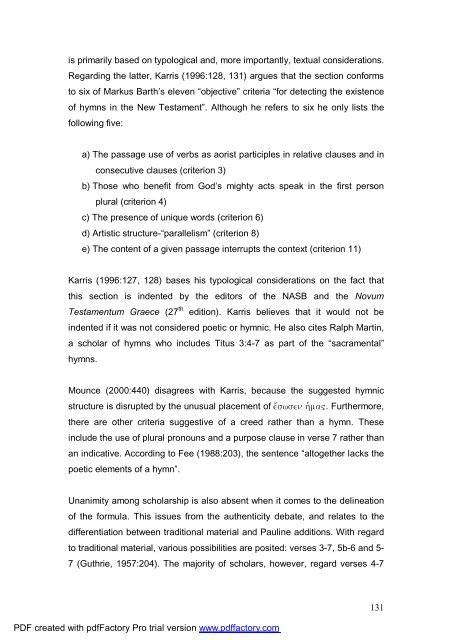A Text centred rhetorical analysis of Paul's Letter to Titus
A Text centred rhetorical analysis of Paul's Letter to Titus
A Text centred rhetorical analysis of Paul's Letter to Titus
Create successful ePaper yourself
Turn your PDF publications into a flip-book with our unique Google optimized e-Paper software.
is primarily based on typological and, more importantly, textual considerations.<br />
Regarding the latter, Karris (1996:128, 131) argues that the section conforms<br />
<strong>to</strong> six <strong>of</strong> Markus Barth’s eleven “objective” criteria “for detecting the existence<br />
<strong>of</strong> hymns in the New Testament”. Although he refers <strong>to</strong> six he only lists the<br />
following five:<br />
a) The passage use <strong>of</strong> verbs as aorist participles in relative clauses and in<br />
consecutive clauses (criterion 3)<br />
b) Those who benefit from God’s mighty acts speak in the first person<br />
plural (criterion 4)<br />
c) The presence <strong>of</strong> unique words (criterion 6)<br />
d) Artistic structure-“parallelism” (criterion 8)<br />
e) The content <strong>of</strong> a given passage interrupts the context (criterion 11)<br />
Karris (1996:127, 128) bases his typological considerations on the fact that<br />
this section is indented by the edi<strong>to</strong>rs <strong>of</strong> the NASB and the Novum<br />
Testamentum Graece (27 th edition). Karris believes that it would not be<br />
indented if it was not considered poetic or hymnic. He also cites Ralph Martin,<br />
a scholar <strong>of</strong> hymns who includes <strong>Titus</strong> 3:4-7 as part <strong>of</strong> the “sacramental”<br />
hymns.<br />
Mounce (2000:440) disagrees with Karris, because the suggested hymnic<br />
structure is disrupted by the unusual placement <strong>of</strong> e[swsen hJma". Furthermore,<br />
there are other criteria suggestive <strong>of</strong> a creed rather than a hymn. These<br />
include the use <strong>of</strong> plural pronouns and a purpose clause in verse 7 rather than<br />
an indicative. According <strong>to</strong> Fee (1988:203), the sentence “al<strong>to</strong>gether lacks the<br />
poetic elements <strong>of</strong> a hymn”.<br />
Unanimity among scholarship is also absent when it comes <strong>to</strong> the delineation<br />
<strong>of</strong> the formula. This issues from the authenticity debate, and relates <strong>to</strong> the<br />
differentiation between traditional material and Pauline additions. With regard<br />
<strong>to</strong> traditional material, various possibilities are posited: verses 3-7, 5b-6 and 5-<br />
7 (Guthrie, 1957:204). The majority <strong>of</strong> scholars, however, regard verses 4-7<br />
PDF created with pdfFac<strong>to</strong>ry Pro trial version www.pdffac<strong>to</strong>ry.com<br />
131

















